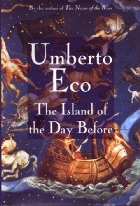
See the cover in
larger glory.
A photo of the professor.
Tal Cohen calls this
book a "masterpiece"
and provides a lengthy
summary.
Dirk Weigelt says
"Totally boring!"
I heard that Daedalus
Books in Hyattsville,
Maryland has 74,000
remaindered copies of
this book. Get yours
cheap! 301-779-4228
Umberto Eco
While Eco is king of playful postmodern fiction, this book is rather long for its plot. To work around the fact that there's really only one major character, Eco relies on a lot of flashback and additional characters whose reality is inconsistent. Roberto's imaginary brother, the nefarious alter ego Ferrante, makes several appearances and gets blamed for Roberto's ill luck. A scientific Jesuit priest relieves Roberto's loneliness (and the reader's sense of monotony), and his death is unlike any other demise in fiction.
Eco has a lot of fun playing with the ideas of fiction and memory, using Roberto's embellished version of history (the only "existing" account of his adventures) as a metaphor for the author's own work in creating history. In the end these devices are what make the book memorable.
Expect Eco's usual dose of ancient languages as well as German, Italian, and arcane English.
Translated from Italian by William Weaver
1994, Harcourt Brace, 513 pp.
| STORY | * * |
| IDIOM | * * * |
| IDEAS | * * * |
| COVER | * * * * * |
That this was a sea of artifice Roberto had long suspected, and it explained why down here cosmographers had always imagined creatures contrary to nature, who walked with their feet in the air. To be sure, the artists of the courts of Europe, who built grottoes encrusted with lapis lazuli, fountains operated by secret pumps, had not inspired nature in her invention of the lands of those seas; any more than it was the nature of the Unknown Pole that inspired those artists. The fact is, Roberto said to himself, both Art and Nature are fond of machination, and that is simply what the atoms themselves do when they aggregate in this way or in another. Is there any more artificed wonder than the tortoise, work of a goldsmith of thousands and thousands of years past, who fashioned this Achilles' shield patiently nielloed, imprisoning a serpent with its feet? At home, he continued his musing, everything that is vegetal life has the fragility of a leaf with its veins and of the flower that lasts the space of a morning; whereas here the vegetal is like leather, a thick and oily matter, a scaly sheath prepared to resist the days of mad suns. Every leaf -- in these lands where the wild inhabitants surely do not know the art of metals or of clays -- could become instrument, blade, goblet, spatula, and the petals of the flowers are of lacquer. Everything vegetal here is strong, while everything animal is weak, to judge by the birds I have seen, spun from varicolored glass, while at home we have the strength of the horse, the stubborn sturdiness of the ox.... And what of fruits? At home the complexion of the apple, ruddy with health, denotes its friendly taste, whereas the livid mushroom betrays its hidden venom. Here, on the contrary, as I saw yesterday and during the voyage of the Amaryllis, there is the witty play of opposites: the mortuary white of one fruit guarantees vivid sweetness, whereas the more russet fruits may secrete lethal philters. With the spyglass he studied the shore and glimpsed between land and sea some climbing roots that seemed to leap towards the open sky, and clumps of oblong fruits that revealed their treacly ripeness by appearing as unripe berries. And he recognized on some other palms coconuts yellow as summer melons, whereas he knew they would proclaim their maturity by turning the color of dead earth. So to live in this terrestrial Beyond -- he had to remember, if he was to come to terms with its nature -- he should proceed in the direction opposite to his instinct, for instinct was probably a discovery of the first giants, who tried to adapt themselves to the nature of the other side of the globe. Believing the most natural nature was that to which they had become adapted, they thought nature naturally born to adapt herself to them. Hence they were sure the sun was small, as it seemed to them, whereas certain leaves of grass were immense, if they looked at them through eyes close to the ground. To live in the Antipodes, then, means reconstructing instinct, knowing how to make a marvel nature and nature a marvel, to learn how unstable the world is, which in one half follows certain laws, and in the other half the opposite of those laws.[p. 101 ff.]
